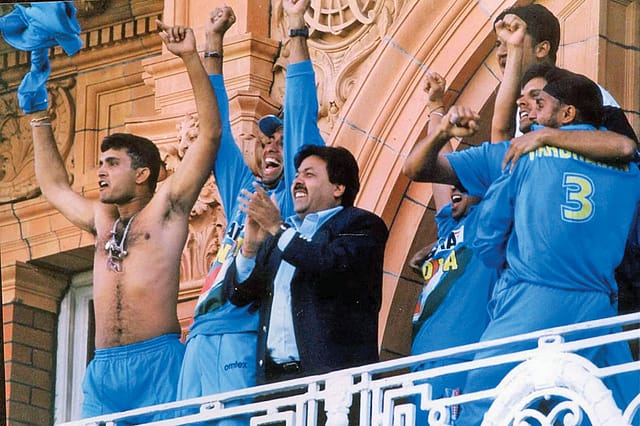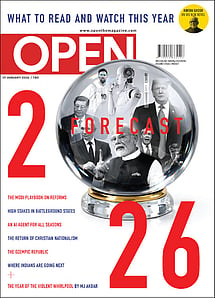Sourav Ganguly: Lord’s and Master

AS WE CELEBRATE Edgbaston, let me remind everyone that winning overseas and consistently is a recent phenomenon in Indian cricket. Indian national teams after Independence had failed to conquer overseas shores for the best part of 70 years. Successes in 1971 in the Caribbean and in England, and thereafter in 1986 in England notwithstanding, India, till the late 1990s, were a poor traveller. Except for a 1–0 series win in Sri Lanka in 1993, away wins were few and far between. India lost 0–1 to England in 1990, 0–4 to Australia in 1992, 0–1 to South Africa in 1992, 0–2 to England in 1996, 0–1 to the West Indies in 1997, 0–2 to South Africa in 1996–97 and 0–3 to Australia in 1999-2000. Despite having players of the calibre of Sachin Tendulkar, Rahul Dravid, VVS Laxman, Anil Kumble, Sourav Ganguly and Javagal Srinath in the team, the poor away record was something Indian fans had reluctantly come to terms with. Every away tour was met with a sense of inevitability, and all there was to celebrate were individual performances. Failure to chase down totals like 120 in Barbados in 1997 was inexplicable and will forever constitute the lowest point of Tendulkar's captaincy. It was Sourav Ganguly, made full-time captain close to a year prior to the Australia series in early 2001, who was determined to change this poor away record.
"Something had to be done. It was unacceptable to me that we travelled abroad to always come back second best. In fact, we had the mindset that it was beyond us to win overseas, and even a draw was an acceptable result," Ganguly said.
"So, how did you go about changing such a mindset?" I asked him. While the players remained the same, something different was done in the period between 2001 and 2005, when India started performing consistently well overseas. And that's what will be the enduring legacy of Sourav Ganguly as captain of the Indian team.
2026 Forecast
09 Jan 2026 - Vol 04 | Issue 53
What to read and watch this year
I have known Ganguly for close to 25 years now. He was a senior at St Xavier's College, Calcutta (now Kolkata), and the one thing that has always been the case with him, for good or bad, is a sense of self-belief. He takes time in picking his people, but once he does so, he backs them for life. His captaincy philosophy was no different. With players like Virender Sehwag, Zaheer Khan, Harbhajan Singh, Yuvraj Singh and a host of others, including MS Dhoni, Ganguly backed them because he thought each of them could do a job for India.
Moving away from favouritism and regional selection, Ganguly made sure that youngsters from all across the country made it to the Indian team and were given a fair run to prove themselves. And, in doing so, he backed his instincts more than anything else. In the case of Dhoni, for example, arguably India's best white-ball captain and finest finisher of all time, Ganguly had heard of him as an unorthodox big-hitting batsman-wicketkeeper in 2002–03. Most would have wanted to see him first before speaking about him to the selectors. Not Ganguly.
"A number of people I had regard for, who were Talent Research Development Officers appointed by the BCCI, mentioned Dhoni to me. [They] said here is a player who could hit the ball long with effortless ease and could be a big-match player. I remember speaking to the selectors and requesting them to pick him for India A. They asked me who this player was and if I had seen him. I said, 'No, I had not. But I also do not want to waste precious time.' I insisted Dhoni be given a chance, and his performances in the next 12 months made sure we could go ahead and pick him in the senior Indian team for the Challengers in February 2005."
Ganguly forever believed that India's strength was spin bowling, both at home and overseas. He was always keen on playing Harbhajan and Kumble in tandem if the opportunity presented itself. Playing two spinners prompted him to bat first on a green pitch at Headingley in August 2002, a decision that would give his spi-nners a crack at England in the second innings. He was backing his bat smen to step up and put up a challenging score in difficult conditions and set up the game for the bowling unit. It was a gressive captaincy and a departure from what Indian captains were used to doing on foreign soil.
"I must tell you Ian Botham looked at me with disbelief at the toss when I announced my decision to bat first. He couldn't come to terms with the decision! Thankfully for me, Rahul played exceptionally well, and then both Sachin Tendulkar and I followed up with hundreds to bat England out of the game. Each of the bowlers then did the job for us, with Anil and Harbhajan sharing 11 wickets between them. This win will always rank as one of our best wins in England," Ganguly asserted.
The Test series was preceded by an emphatic win in the NatWest tri-series against England and Sri Lanka, and yet again, the architects were two youngsters whom Ganguly was instrumental in getting into the team—Yuvraj Singh and Mohammad Kaif.
"What I saw of Yuvraj impressed me a lot. He had this free flow of the bat and could hit the ball a long way. I was seeing the answer to my middle-order woes in the one-day game. Yes, he was young and not a finished product yet, but he was good enough to play international cricket. We picked him for the second edition of the ICC Knock Out Trophy in Nairobi in 2000, and he started his career with a sensational innings of 84 against Australia that knocked the world champions out of the tournament."
In the NatWest tri-series final, Yuvraj and Kaif stitched together a superlative rearguard 121-run sixth-wicket partnership to clinch a thriller at Lord's. Sensing something incredible was unfolding, most Indian players refused to move from their positions in the dressing room throughout the innings. No one left the room for even a bio break, and it was only after the match was won that normalcy resumed. What emerged as a lasting image from among the euphoric celebratory moments that ensued had the captain at centrestage. To commemorate the occasion, Ganguly had done something that has made him a part of the Lord's folklore. A traditionalist of sorts, belonging to a conservative upper-class Kolkata family, it was unthinkable to see Ganguly open his shirt and wave it like a torch bare-chested from the Lord's balcony. Yes, it was done in response to what Andrew Flintoff had done in Mumbai a year earlier, but that Ganguly, a soft-spoken Bengali, could do what he did was in itself a statement of what this team was capable of. This was a team that wasn't going to be constrained by traditional values and ideas and was willing to express itself anywhere in the world.
Here was an Indian captain who, in a sense, was subverting everything that the Lord's stood for. And what is important is that he did so knowingly. He was aware it was the Lord's balcony. He was aware cameras were on him, and in hindsight, he would never do it again, something he says time and again. But this rather outrageous gesture, it must be said, went a long way towards breaking barriers and giving the Indian team its newfound identity, one that Shubman Gill is carrying with him as India steps out at the Lord's yet again on July 10.
